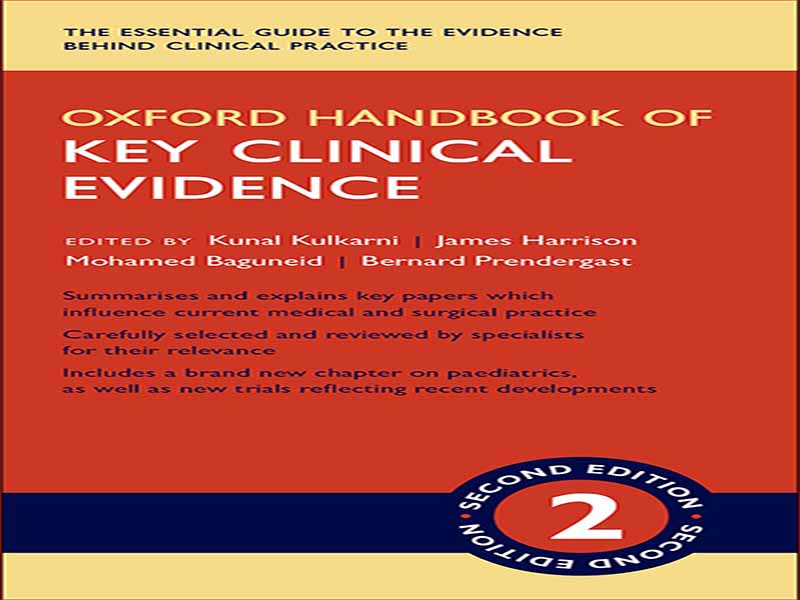- عنوان کتاب: Oxford Handbook of Key Clinical Evidence
- نویسنده: Kunal Kulkarni
- حوزه: تشخیص پزشکی
- سال انتشار: 2016
- تعداد صفحه: 993
- زبان اصلی: انگلیسی
- نوع فایل: pdf
- حجم فایل: 17.1 مگابایت
اگر در حال خواندن این کتاب هستید، احتمالاً حداقل علاقه مبهم به EBM (پزشکی مبتنی بر شواهد) دارید. به هر حال، این یک کلمه کلیدی اجتناب ناپذیر در پزشکی مدرن است و طیف وسیعی از واکنش ها را برمی انگیزد – از دافعه تا اعتقاد به آن به عنوان نوشداروی عمل بالینی صحیح. صرف نظر از پیش فرض های شما، هدف ما از این کتاب همیشه ساده بوده است: نشان دادن این موضوع که EBM هنگامی که در زمینه بالینی مناسب به کار می رود، ابزاری قابل دسترس و ارزشمند است. برای این ویرایش دوم تازهسازی شده، هدف ما حفظ این رویکرد ساده برای تفسیر EBM است. بزرگترین مشکل با EBM این است که خوانندگان مختلف مقاله را متفاوت تفسیر می کنند. برای مثال، دیدگاه یک دانشگاهی یا یک آماردان ممکن است به طور قابل توجهی از دیدگاه یک پزشک متمایز باشد. هر دو ممکن است در تحلیل خود درست باشند، اما پیشینه، تجربیات و اهداف نهایی آنها تفاوت دیدگاهها را در نتیجهگیریهایشان به همراه دارد. در بسیاری از موارد، این می تواند به سادگی عدم آموزش باشد که منجر به اجتناب از نقد در جنبه های خاصی از مقاله می شود. به عنوان مثال، دانشجویان پزشکی در طول دوره آموزشی خود در معرض آمارهای کاربردی کمی قرار می گیرند و نقد بخش نتایج را به یک کار ترسناک تبدیل می کنند. ندانستن چگونه و به کجا باید نگاه کرد می تواند EBM را یک جانور رام نشدنی جلوه دهد که بهتر است برای شخص دیگری باقی بماند. با این حال، بدون بررسی دقیق، EBM بی معنی است. عوامل خارجی، مانند هزینه و بوروکراسی، ذاتی همه سیستم های مراقبت های بهداشتی هستند، اما نباید سهم شواهد با کیفیت بالا را در پیشرفت های بالینی محدود کنند. امید ما این است که این کتاب به منابع بسیاری که در سالهای اخیر پدید آمدهاند بپیوندد تا اطمینان حاصل شود که EBM از تأثیرات ناروا عاری میماند و به موضوعی تبدیل میشود که بخشی از تمرین بالینی روزمره برای کارکنان مراقبتهای بهداشتی در همه سطوح است. و پس زمینه ها ما سعی کردهایم تعادلی بین پیچیدگی و دسترسی برقرار کنیم تا اطمینان حاصل کنیم که حقایق علمی و آماری اولیه در یک زمینه بالینی عملی تفسیر میشوند. فصلهای مقدماتی زمینه و چارچوبی را برای این فرآیند ارائه میکنند، در حالی که تفاسیر مبتنی بر الگوی پزشکان متخصص ما، فرآیند تحلیل انتقادی مقالاتی را نشان میدهد که تغییرات کلیدی در عملکرد بالینی آنها ایجاد کردهاند. این کتاب نظرات و بدون شک انتقادات را به خود جلب خواهد کرد. فراگیر نیست و شکاف های اجتناب ناپذیری وجود دارد. یکی از این موارد حذف شده از نسخه اول (که اکنون به آن پرداختیم) حذف پزشکی کودکان بود – تخصصی که چالش های EBM را در یک جمعیت پیچیده بیمار پذیرفته است. EBM یک علم غیر دقیق است که نظر و اجماع جزء ارزشمندی از کاربرد ایمن آن در عمل بالینی را تشکیل می دهد. ما از بازخورد شما استقبال می کنیم (لطفاً این را از طریق صفحه کتاب در وب سایت OUP ارسال کنید – M http://www.oup.com/uk/medicine/handbooks). ما از نظرات خوانندگان خود قدردانی می کنیم و تلاش خواهیم کرد تا تغییرات پیشنهادی را در نسخه های بعدی بگنجانیم.
If you are reading this book, then you probably have at least a vague interest in EBM (evidence- based medicine). After all, it is an inescapable buzzword in modern medicine and provokes an extreme range of reactions— from repulsion, to a belief in it as the panacea of sound clinical practice. Regardless of your preconceptions, our aim for this book has always been simple: to demonstrate that EBM is an accessible and valuable tool when applied in the appropriate clinical context. For this refreshed second edition, we have aimed to maintain this straightforward approach to the interpretation of EBM. The greatest difficulty with EBM is that different readers will interpret a paper differently; for example, an academic’s or a statistician’s view may be markedly distinct from that of a clinician. Both may be correct in their analysis, but their differing backgrounds, experiences, and ultimate goals yield differences of opinion in their conclusions. In many cases, it can simply be a lack of training that leads to avoidance of critique in certain aspects of a paper. For example, medical students receive little exposure to applied statistics during their training, making critique of the results section a frightening task. Not knowing how and where to look can make EBM seem an untamable beast best left for someone else to deal with. However, without rigorous scrutiny, EBM is meaningless. External factors, such as cost and bureaucracy, are inherent to all health- care systems but should not restrict the contribution of high- quality evidence to clinical advances. Our hope is that this book will join the many resources that have sprung up in recent years to ensure that EBM remains free from undue influences and becomes a subject that is part- and- parcel of everyday clinical practice for health- care workers of all levels and backgrounds. We have attempted to strike a balance between complexity and accessibility in ensuring that primary scientific and statistical facts are interpreted within a practical clinical context. The introductory chapters provide the background and framework for this process, while the template- based interpretations of our expert clinicians demonstrate the process of critical analysis of papers that have made key changes to their clinical practice. This book will attract comments and, no doubt, criticism. It is not all- encompassing, and there are unavoidable gaps. One such omission from the first edition (that we have now addressed) was the exclusion of Paediatrics— a specialty that has embraced the challenges of EBM in a complex patient population. EBM is an inexact science, with opinion and consensus forming a valuable component of its safe application to clinical practice. We welcome your feedback (please submit this via the book’s page on the OUP website— M http:// www.oup.com/uk/medicine/handbooks). We appreciate the opinions of our readers and will endeavour to incorporate suggested changes into future editions.
این کتاب را میتوانید بصورت رایگان از لینک زیر دانلود نمایید.
Download: Oxford Handbook of Key Clinical Evidence




































نظرات کاربران